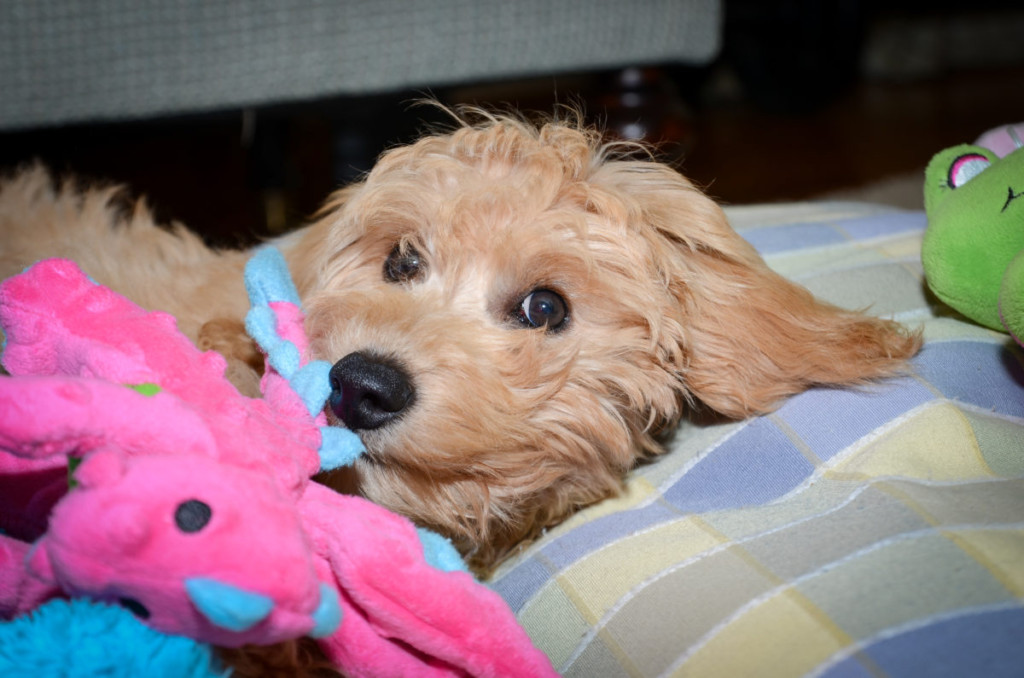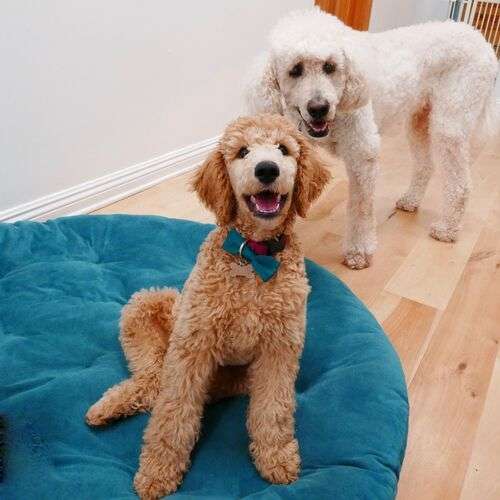Are Goldendoodles Better in Pairs?
Everything you need to know and consider when getting a second dog, especially a Goldendoodle!
Goldendoodles, whether they are Standard or Mini, will steal your heart very quickly. They are a mix between Poodles and Golden Retrievers, which creates not only a playful, active, loyal pup, but one that is pretty adorable and increasing in popularity.
This friendly by nature, social breed loves to cuddle and play, and because you are getting a genetic mixture of Golden Retrievers (notoriously playful and loyal) and Poodles (probably best known for being very intelligent and non-shedding), you will find yourself with a precious, hypoallergenic puppy with characteristics of both parents that fits perfectly into your life.
The way Goldendoodles are bred allows for a variety in the size of dog and coat style and color, so it seems like you could find the perfect pet for your life pretty easily. So, why stop with one?

Is it best to take advantage of this impressive breed of dog and bring a pair into your home, or is less truly more in the case of Goldendoodles?
I looked into whether it is better to keep Goldendoodles in a pair or if you will have better luck handling them one at a time.
Are Goldendoodles Better in Pairs?
So, are Goldendoodles better in pairs? Keeping two Goldendoodles together is a great idea if you properly train them and monitor them when they are young. Goldendoodles are very social dogs who are prone to separation anxiety, and another Goldendoodle can help prevent loneliness.
I explored some of the biggest hurdles and benefits for you to consider, and of course, ultimately, the decision about your time, resources, and overall goals will fall to your personal preference, but officially speaking: Goldendoodles are pretty fantastic in pairs.

Things To Know About Getting A Second Goldendoodle
By nature, Goldendoodles are wonderful with other animals, and there are clear health benefits to having a play partner; additionally, since they are pretty social dogs, they tend to get lonely and bored (anyone who has ever had a bored puppy on the loose knows ALL the ways that can be a disaster), so having another Goldendoodle around can help keep them stimulated.
Experts advise that it’s less than ideal to leave these dogs alone for long periods of time. If they are too bored, they may not stop at just chewing on a few more things than you’d prefer, they can actually end up adopting destructive behaviors or even becoming depressed.
Because they are such loyal dogs, Goldendoodles can grow so attached to their human that they suffer from separation anxiety, so a pair of Goldens can often help ease that anxiety in one another. Having 2 Goldendoodles encourages healthy socialization.
It’s very interesting that single dogs who are alone during the day or who don’t have daily play dates with other dogs are more prone to depression (many times without major external indicators to let humans know what’s going on) and because dogs are, by nature, pack animals, they will forge strong connections with whatever “pack” is around them.
This means if there isn’t another dog to form their pack, we, their owners, become their de facto pack, and this increases the likelihood of separation anxiety when we are out and about without them.
Potential Negatives Associated With Multiple Dogs
There are some potentially negative components to consider as well. While most signs point to yes, when it comes to whether or not you should get two Golden Doodles at once, let’s shake the Magic 8 Ball a little more.
For every perk in owning a pair of Goldens, there is at least a small counterpoint that should be considered before making your final decision.
More Of Everything
Having multiples of anything is going to require an increase in your investment – more time, more expenses, more toys, more food, and more energy put into training and providing exercise/activity for them, but you will also get an increase on your returns: more puppy kisses, more entertainment watching them wrestling around, more devotion from your furry friends, more confidence in their happiness when you aren’t around, and very often, an increase in your Goldendoodle’s overall health and life expectancy.
If you already have a dog and are considering adding another into the mix now, there are a few things to take into account. The age of your current pet can play a role in how smoothly they will adapt to having a younger puppy around.
The hybrid temperament of Goldendoodles makes them ideal dogs to have around children and other pets, so bringing two Golden Doodles into the same household, even with an age difference, is typically still really successful.

There are many arguments that have been made for getting your dogs at different stages of life as opposed to getting two puppies at once.
Adding a young puppy to a family with an older Goldendoodle can make it easier for you, the owner because you won’t have to potty train two at the same time, and you can rely on the example set by the older dog to oftentimes help condition the new dog to adopt healthy behaviors and curtail some of the “puppy energy” that can sometimes lead to chaos.
There is always a risk of the dog that has been in the house longer behaving in a “possessive” or “territorial” way both over you and their space when the new puppy is introduced.
Goldendoodles are not traditionally known for this behavior, but since they are the genes are a mix of Golden Retrievers and Poodles, every single dog will vary in which ancestry line it displays more qualities.
You know your pet and its temperament, and while traditionally this isn’t something you should anticipate trouble with, you should, of course, use your own judgment as to what is healthiest and most beneficial to the dog already in your home.
Potty training and maintaining that housebroken status is a huge topic to consider. For the most part, due to their intelligent nature, you won’t have much of a struggle even if you are bringing a puppy into a house with an older dog.
Usually, once a dog is spayed or neutered, the hormones that make them want to mark territory are negated, so your more mature Golden won’t suddenly forget that it’s potty trained when a younger one shows up.
If you are getting two Goldendoodle puppies at the same time, spaying and neutering them around six months of age is extremely helpful in making sure your pet doesn’t mark things, and it can help prevent illness and disease and decreases the potential for aggressive behaviors.
Doodles Are Pack Animals
As we established earlier, Goldendoodles are very social and will form strong bonds with their “pack.” This is primarily a positive trait and a great reason to have them in pairs, but be sure you are committed and able to keep both animals together because if one is suddenly gone (whether by choice, circumstance, or eventually death), your dog may struggle with depression and loneliness.
This is something to consider when deciding whether to add a new puppy to a home with a senior dog. They will inevitably attach to one another, so think through expected timelines and determine whether or not the timing is right for your family.
Getting two puppies at the same time means your dogs will grow up together and become dependent (to a great extent) on one another. This is positive in most instances, but when it comes to how they process being away from one another, try to think of any hiccups your schedule may cause to your Goldendoodle pair.
Two Goldies: Is It Right For You?
Once you have determined if you have the time, money, and resources to take on two Goldendoodles at once, you’ll want to decide how to best match your pair. Many people have opinions on the best gender pairing, but there is not actually any research to back one pattern being more successful than another.
So, if you want two males Goldendoodles, two female Goldendoodles, or a male / female Goldendoodle combo, it’s really up to your own preference. Male Goldendoodles should get along just as well as any of the other combinations.
Another thing to consider is what category, size, and coloring you want. Goldendoodles are crossbred into different categories, which determine their genetic breakdown and their coat style.
F1 Goldendoodle means that the dog is a first generation Goldendoodle – it was crossbred with a pureblood Golden Retriever and a pureblood Poodle, making it a 50% / 50% genetic split between the breeds. The coats on F1 Goldendoodles are a little straighter / shaggier with some curl.
F1b is when you take an F1 (50/50) and backcross it with a purebred Poodle (this makes it 25% Golden Retriever, 75% Poodle) The coats on an F1b will have a little more curl to it, since it is a higher percentage of Poodle, and you will find more variety in the coat colors in this generation. This is also probably the best generation for families with allergies to dander.
F2 Goldendoodle just means that two F1’s were bred together. You will still get the 50 / 50 split, it’s just a second generation in. So, instead of a purebred Poodle and purebred Golden Retriever being bred, you are getting a hybrid of each being bred.
Coat color and texture will be virtually the same as you see in the F1 generation, but you will not find the tighter curls since there isn’t a higher level of Poodle DNA. It is important to note that since there is Golden Retriever DNA at play, you won’t get a dog that “never sheds,” but there will definitely be a decreased amount of shedding.
F2b is where a little more math comes into it. The F2b generation is created when an F1 (50/50) & F1b (25% Golden Retriever / 75% Poodle) are bred with one another. This genetic breakdown gives you a dog with a curlier coat because the Poodle DNA will be higher. By that same standard, there is an increased chance that you will see stronger Poodle traits coming out.
If you’ve decided to bring a pair of Goldendoodles into your life (or to add a second one to your home), you really can’t go wrong so long as you pick a reputable breeder or rescue. You can get different generations and different coat colors, or go for two of the same thing, and you can be confident that you are creating an environment where your dogs can bond with you and one another to make the happiest home possible for all of you!